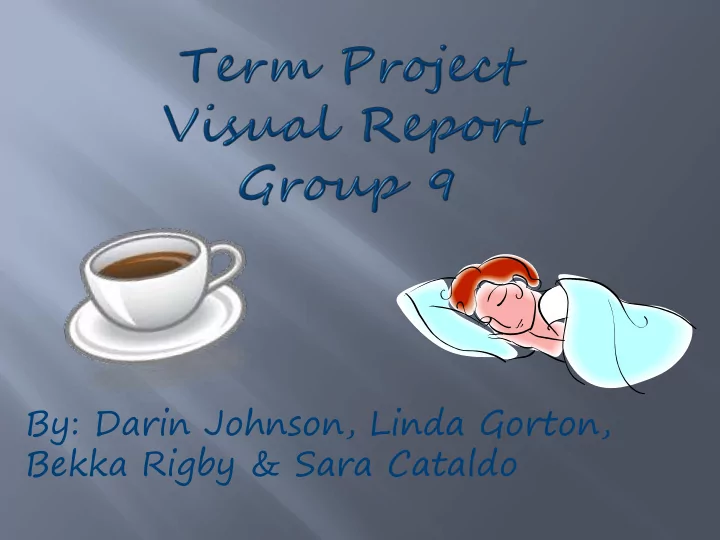

By: Darin Johnson, Linda Gorton, Bekka Rigby & Sara Cataldo
Slide 3 – Research Topic & Data Collection Plan Slide 4 – Graph & Variable Data (Cups of Coffee on Average Per Day) Slide 5 – Graph & Variable Data (Hours of Sleep on Average Per Night) Slide 6 – Graph Comparing the Variables Slide 7 – Results & Conclusions Final Slide – List of Group Members & Their Contributions
" For adult women, is number of cups of coffee per day related to hours of sleep ?" Data Collection – Systematic sample; start at a public location. Interview every 3 rd woman, starting with the 3 rd woman until reach 100 particpants. Interview Questions: 1.Would you be willing to answer a few quick questions regarding sleep and coffee? 2.Are you 18 years old or older? If yes proceed to question 3. 3. Do you live in Utah? If yes proceed to Question 4. 4. Do you drink coffee? If yes move on to complete the rest of the questions. If no on any of the first four questions, go to the next potential subject. 5.How many cups of coffee do you drink on an average day? 6.How many hours of sleep do you get on an average day?
General Summary Count Mean IQR St. Dev. Variance Range Mode Outliers 100 2.698 1.75 1.574 2.479 9.7 2 8,10 Five number Summary Min 25th% Median 75th% Max 0.3 1.75 2.5 3.5 10
General Summary Count Mean St. Dev. Variance Range IQR Mode Outliers 10 07.15 1.222 1.492 6.5 2 7 None Five Number Summary Min 25th% Median 75th% Max 4.5 6 7 8 11
Line of regression equation: y = - 0.17612x + 7.6251 Linear Correlation Coefficient ( R ) =- 0.227
Results and Conclusions Is the amount of coffee drank per day related to the amount of • sleep women get per day? The negative slope on the regression line supports the inverse • correlation between the variables. An R value of -0.227 indicates that the variables fluctuate in • opposite directions. Knowing the physiologic effects of caffeine on the human body. • Supported by the data we can conclude that, increased coffee consumption especially in high amounts correlates to less hours of sleep per night.
Contributing group members Sara Cataldo- Slides 1-2 Linda Gorton- Slides 4-6 Darin Johnson- Slide 7 and compilation of presentation Bekka Rigby- Slide 3
Recommend
More recommend